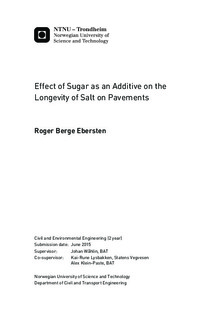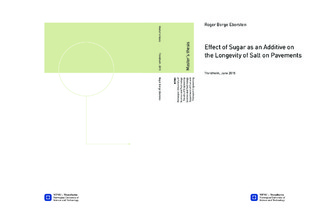| dc.description.abstract | In winter maintenance of roads chemicals are applied to the road with the aim of
ensuring that the friction is at an acceptable level so that the road is safe and
accessible. Sodium chloride is a common used chemical due to its effect and price.
There is however negative impacts related to the use of salt, it is not good for the
environment (like vegetation and groundwater). A reduction of the salt usage is
therefore highly desirable. One way of reducing the salt applied on the roads, is to
replace parts of it with other more environmental friendly substances that gives the
same or better effect or/and an increased longevity. SafeCote is an additive that has
been more and more used in the recent years in some countries of the world.
According to the manufacturer this product both makes the salt more effective on
lower temperatures and gives an increased longevity.
This thesis studies the effect of sugar (which is one of the components in SafeCote)
as an additive has on the longevity of salt. To study this, it first had to be collected
information about what has been done in this area before. Therefore the thesis
presents an overview of literature on residual salt, like mechanisms that remove salt
from the road and the believed effect of dissolution of salt in these loss mechanisms.
The laboratory experiment conducted in this thesis was new and unknown, so a
scope of the thesis was also to develop the experiment and make a judgement over
what could be changed in further work on the experiment. In the experiment asphalt
substrates are applied with different salt/sugar solutions, and after it had dried the
substrates were rinsed with water to simulate rain. Conductivity of the water that had
been on the substrates was measured, and in that way the residual salt on the
substrate could be calculated.
The results from the experiment showed that the more sugar was added, the more
residual salt was left on the substrate. After first rinse in room temperature the
NaCl/sugar mixes 90/10, 50/50 and 33/67 had respectively 27%, 46% and 81% more
residual salt on the substrate than NaCl with no added sugar. After five rinses there
was almost no difference between them. When moving the experiment into the ice
laboratory, where NaCl with no sugar and NaCl/sugar 50/50 were tested, the results
showed that NaCl/sugar 50/50 had an amount of residual salt after first rinse that was
only 16% higher than NaCl with no sugar. However, compared to tests performed in
room temperature, there was a difference after five rinses. NaCl/sugar 50/50 had at
this stage 24% more residual salt left on the substrate than NaCl with no sugar. One
possible hypothesis that explains the results might be that the dissolution rate is
slowed down when sugar is added.
The experiment should be performed in an ice laboratory to ensure that it has the
same temperature as out on the roads in the winter. Further development of the
experiment should focus on how the water is applied and how to make it run off. The
exactly same procedure for these operations is not possible for a human to repeat
several times. To get a more reliable experiment the operations mentioned should be done in other ways. | |

